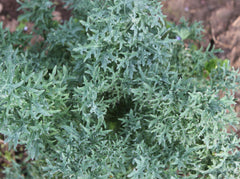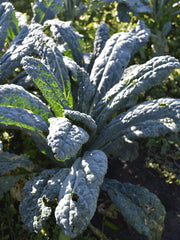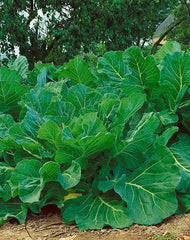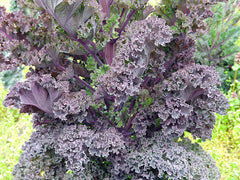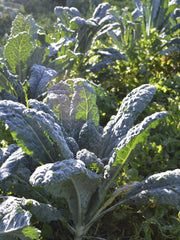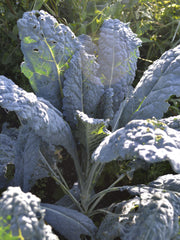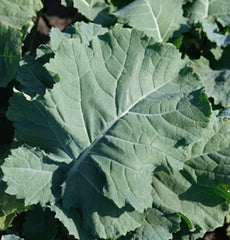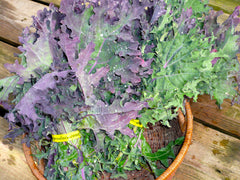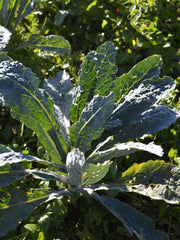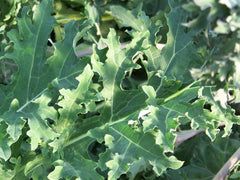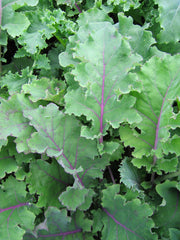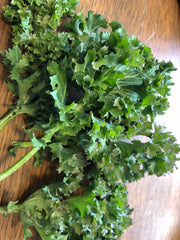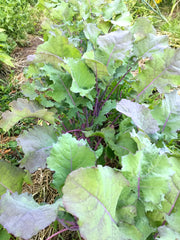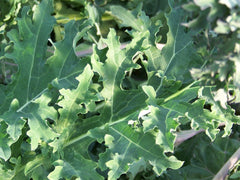Perennial Kale, Homesteader's Kaleidoscope Grex
HOW TO GROW PERENNIAL KALE
Start new perennial kale plants in a flat indoors when you sow other seeds of the brassica family in your climate. When baby plants are 3-5 inches tall, transplant into 1 or 2 gallon pots. Plant the larger plants into garden beds in the fall. Perennial kale is also easy to direct sow into a well prepared garden bed. Keep watered and weeded while they establish. Propagation through a cutting is also possible during cooler months of fall, winter or spring. Cut a side branch of the plant, and stick it in a garden bed or nursery pot. Keep moist while the new roots develop. These plants typically live for 3 years before slowing their production of leaves. Soil pH 6.6-7.5. Hardiness zones 6-10. Perennial.
Planting Depth 1/4"
Plant Spacing 18-24”
Row Spacing 3-4’
Storage Refrigerate
Full Sun, Moist Well Drained
Planting Depth 1/4"
Plant Spacing 18-24”
Row Spacing 3-4’
Storage Refrigerate
Full Sun, Moist Well Drained
- 100 Seeds$4.10
This beautiful variety of perennial kale is easy to grow and very productive. The leaves are nutritious and delicious! This is a grex type, which means that the plants are genetically diverse, and so one can expect a variety of different colors, leaf shapes, and forms. The plants do well in hot, arid conditions and ...
This beautiful variety of perennial kale is easy to grow and very productive. The leaves are nutritious and delicious! This is a grex type, which means that the plants are genetically diverse, and so one can expect a variety of different colors, leaf shapes, and forms. The plants do well in hot, arid conditions and yet also have cold hardiness down to zone 6 without protection from the elements. They grow 3’ ft wide, by 5’ tall on average. Homesteader’s Perennial Kale was bred by Chris Homanics of Head, Hands, and Heart in NW Oregon and Washington. Also known as perpetual kale, bush kale, and branching kale. Homesteader’s Kaleidescopic Perennial Kale Grex is released under the OSSI (Open Source Seed Initiative) license to protect this important genetic material from large multinational seed conglomerates that might seek to patent or otherwise control it. So, select out your favorite unique perennial kales and share with friends. The Open Source Seed Initiative (OSSI) pledge states: “You have the freedom to use these OSSI-Pledged seeds in any way you choose. In return, you pledge not to restrict other’s use of these seeds or their derivatives by patents or other means, and to include this pledge with any transfer of these seeds or their derivatives.” More information on OSSI can be found at osseeds.org. Tags: Season: Spring Fall.
Native to Europe. Was commonly grown in medieval period but today almost forgotten except by a growing group of permaculturists and kale enthusiasts.
Native to Europe. Was commonly grown in medieval period but today almost forgotten except by a growing group of permaculturists and kale enthusiasts.
Learn More
Meet Your Farmer
We promote fair trade, organic practices and environmental responsibility throughout the Restoration Seeds supply chain. Below are the family farmers and seed suppliers who bring our open pollinated seeds to you.
Homestead Culture
Conventional
Seed grower since 2018

Homestead Culture is a small family homestead in Southern Oregon offering seeds for gardening enthusiasts, homesteading and permaculture. We focus on seeds for perennial foods, flowers, herbs and wild plants that offer abundant nourishment and beauty to our gardens, homes and hearts. As busy homesteaders we often look to embrace plants that are reliable, resilient, multi-talented and produce abundantly. It is the seeds from these, our mainstay plants, that we are honored and excited to share with you. We wish you many blessings both in and out of the garden!
Reviews
